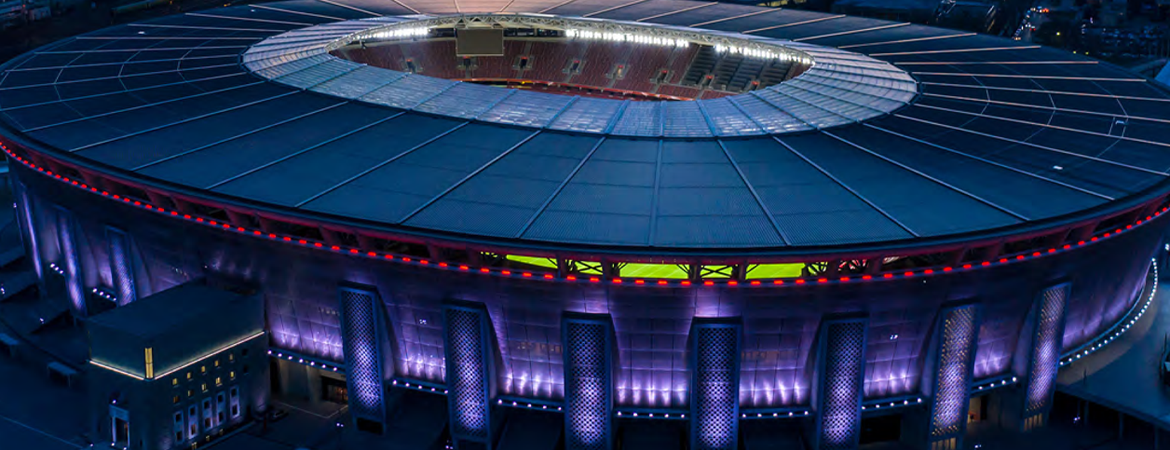We all have experienced the live streaming of sporting events from the comfort of our homes and know the joy we get when our favourite teams are playing. Broadcasting technology has revolutionised how sporting events are telecasted from the stadium to our smart televisions. But the magic and thrill of watching a game live sitting in a stadium is entirely different.
Beyond aesthetics and glass facades, modern stadiums come equipped with integrated high-speed wired and wireless connectivity. This gives the audience an entirely different experience, one in which they can enjoy their favourite games and events. New technologies have emerged, driven by four key factors – maximising fan engagement, unlocking new revenue streams, increasing operational efficiencies, and improving sustainability.
Stadiums have now transformed into areas of high-density zones with thousands of audiences in confined spaces. All of them demand high-speed connectivity, and this places significant performance requirements on networks,
The ability to establish a strong and reliable connection is crucial for stadiums to keep up with the latest innovations, utilise digital content delivery, and improve the overall experience for spectators. It also helps with concessions, advertising, subscriptions, and content creation.
Future-proof infrastructure for digital stadiums
For smart stadiums of the future, it is vital that connectivity solutions are deployed in a modular and flexible manner so they can evolve to meet future needs. Fans expect engagement and interaction from anywhere inside—and even outside. New stadium infrastructure that spectators rely on to stay engaged at every point in the venue can’t experience lags, glitches or downtime.
Ensuring the safety of fans and attendees is a crucial aspect of any event. To maintain a smooth flow of traffic and ensure the safety of fans, security systems must maintain uninterrupted network connectivity, regardless of the number of people passing through the gates at once.
A stadium’s network infrastructure must be designed to withstand harsh outdoor conditions and offer water and flame protection for indoor use. Connecting such large-scale buildings with fool-proof connectivity is no easy task, especially in an era where consumers are quick to complain about subpar connectivity.
So, what does an intelligent infrastructure look like:
A robust physical layer– Network environment continues to evolve and cabling is one of the biggest factors in determining usable bandwidth in a network and it’s operational costs.
A well-designed networking infrastructure developed on the back of cutting-edge cabling solutions can significantly improve network performance and availability. Selecting the proper cabling infrastructure up front provides assurance on the correct life-cycle, scalability and flexibility, and up to 50% of a network’s problems can be traced to the cabling infrastructure. A smart cabling infrastructure offers high bandwidth and forward compatibility with next-gen technologies. Optical fibre cable needs to have a longer lifetime. The optical lifetime of the legacy G.652.D fibre-based network is around 8-10 years. Fibre upgradation is necessary to achieve a long (25 – 30 years) optical lifetime, future-proof fibre (A1/A2) will ensure a longer lifetime. Bend-insensitive fibre (A1/A2) offers benefits like resilience to high bends and turns, miniaturisation of passives, de-skilling of field termination and optimised power budgets, providing a solid foundation for hyperscale projects.
Structured cabling becomes a valuable, manageable building asset and IP convergence takes place over fibre and copper cables.
Distributed Antenna Systems (DAS) – This solution provides the best way to ensure reliable 4G and 5G public cellular signals in venues where coverage is inadequate. It works by placing antennas near the users who require them the most, thus providing indoor connectivity. Additionally, it supports multi-operator coverage through on-site base station equipment and is an excellent solution for high-traffic buildings. Distributed Antenna System (DAS) is a perfect solution for stadiums’ in-building wireless connectivity needs. It offers a scalable and painless upgrade process, as additional zones, remotes, and antennas can be added per the growing demands. Unlike other infrastructure models that require a “rip-and-replace” strategy, DAS can be designed correctly to accommodate the evolving needs of stadiums.
The last mile equipment majorly gets connected over data cable which the most preferred connectivity media option. Structured cabling solutions will enable the Enterprise Network Convergence globally – The connected world needs a solution that converges power and data infrastructure to cater to triple-play services and power, PoE Compliant Category Cables designs are the solution for that
STL has the right solution for the stadiums of tomorrow

For next-gen stadiums, STL recommends:
- Inclusion of pre-installed connectivity infrastructure (optic fibre cables and access points) in upcoming building Complexes
- Standardise bend insensitive fibre for inside the premises
- Provision of fire safety guidelines, fire retardant cables
- Provisions for the right category (Cat6A onwards ) of cabling infrastructure inside the buildings/premises.
This will ensure the best network quality, as minimal signal loss is expected in tight bend conditions, reduction in TCO. When we use bend-insensitive fibre, the lifetime of the network increases upto 3x. Changing the entire OFC network inside the building every 5-7 years does not make sense
The international standards and new applications strongly demand use of higher categories for new installations. Enhanced future ready horizontal LAN cabling infrastructure is required to avoid productivity loss due to network bollteneck.
STL’s Estelan is an end-to-end solution in fibre and copper cable connectivity, enabling enterprises to modernise and digitise their large-scale network infrastructure. Its plug-and-play modular system is designed for easy installation and system upgrades and can handle multiple network ports. These solutions follow the highest health and safety standards and are certified by leading industry bodies like RoHS, ETL, UL, and CPR.
Through Estelan, we offer customised end-to-end enterprise connectivity solutions that are optimised for their specific business needs. From conceptualisation to installation, we want our customers’ experience to be seamless. Estelan will help them gain a competitive edge by making connectivity infrastructure competent enough for disruptive technologies and drive business transformation.
















